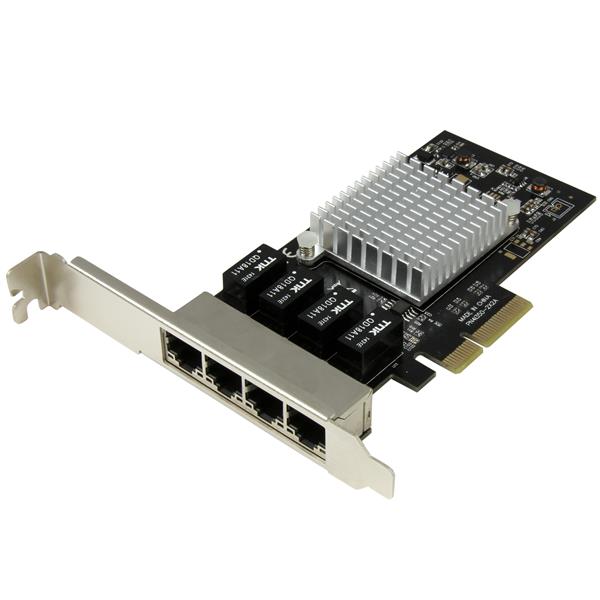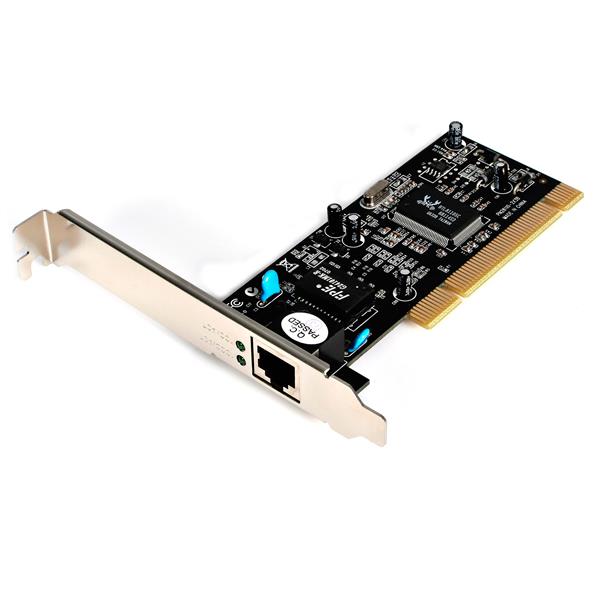10 Gbit Networking Card
The speed of your network affects nearly every device on your home network, whether it be a home-theater PC, an external storage device, or a gaming console. For most networks, the transfer rate of a faster ethernet connection (roughly 12.5 megabytes per second) is the typical speed limit. That may be okay for transferring ordinary files, but it's painfully slow if you're trying to back up a PC to a network device, for example, or to stream a high-definition movie to your living room.The solution? Move up to a gigabit network. Switching over to gigabit (1000-Mbps) speeds increases your potential throughput tenfold, minimizing your transfer times and greatly enhancing your ability to stream high-bandwidth files to connected devices without interference.
Gigabit networking is now a sufficiently that it shouldn't carry too great a cost premium. As for your motherboards, the odds are good that they already have gigabit functionality built in, whether you know it or not. Before we go any further, I should note that this guide does not apply to wireless networks; the factors that constrain speeds on wireless networks are entirely different from those that limit speeds on wired networks.How do you determine whether your equipment is capable of handling gigabit networking?



And if it isn't, how do you build a gigabit network from scratch? Let's start with the basics. Identify Your NetworkDo you already have a gigabit network? The Windows desktop provides no signal to let you know when you've achieved this superspeedy networking feature.
And a lot of factors influence your network transfer speeds-so your gigabit network might crawl along at a data transfer rate of less than 125 MBps for various reasons.You can't tell a gigabit network port from a fast ethernet port just by looking at it. Instead, consult the specification chart or do a little software-driven digging!
Photograph: Chris MannersThe most basic requirement of gigabit networking is that all connected devices must be connected via a gigabit port. In addition, they must be connected to each other with network cables that can handle the bandwidth. For devices such as your router, a gaming console, or an external storage device, the quickest way to discover whether they support fast ethernet (10/100 Mbps) or gigabit ethernet (10/100/1000 Mbps) is to check the devices' specifications in their online descriptions or accompanying manuals. Look for a mention of either 'gigabit networking' or '1000 mbps or Mbps'.You can check the performance potential of your motherboard's network connection in just a few mouse clicks. Start by pulling up your Network Connections window.Your PC's motherboard is a critical component of the gigabit network. If your system came to you prebuilt or if you don't remember relevant details about the motherboard you used in your rig, don't worry.
Click your Windows Start button and select Run (or for more modern-versions of the OS, just point your cursor on the search box and left-click). Type ncpa.cpl and press Enter. The Network Connections window should pop up.Motherboards can vary in how they label the properties of their network controllers.
Scroll through the available properties until you find one that identifies the speed of the device.Right-click the network connection listed as your Local Area Connection (LAN), and left-click Properties. Click the big Configure button that appears to the right of the listing for your network controller. In the new window that appears, open the Advanced tab and scroll down until you find a property labeled 'Connection Type' or 'Speed'. Left-click it and then click the Value field to the right. Scroll up and down through this list of options, looking for anything that starts with a '1000' value or anything that refers to network speeds in gbps (or Gbps). If all you see are '100' values and speeds designated in 'mbps' (or 'Mbps'), your motherboard's built-in Ethernet controller tops out at fast-ethernet speeds.
But you can still upgrade your PC to gigabit networking by installing a third-party gigabit ethernet card.If all of the devices on your network support gigabit functionality, great! If a slower, fast-ethernet device joins a gigabit-ready hub, transfer speeds will crawl only when you access that particular device-a slow device connected to a router won't poison the rest.
Obviously, if you directly connect a gigabit-ready PC to a fast-ethernet device such as a, you'll get only fast-ethernet speeds.Finally, consider your cables. A typical category 5 (Cat 5) cable supports gigabit ethernet, but it's worthwhile to invest in Cat 5e cables if you're building up a gigabit network from scratch. Plain old Cat 5 cabling is now considered obsolete, and Cat 5e cabling meets more-rigorous specifications, enabling it to do a better job than Cat 5 cabling can of minimizing electromagnetic interference. On the other hand, bumping up your cabling to a classification higher than Cat 5e may not benefit your network speeds. For example, Cat 6 cabling doesn't deliver dramatic speed improvement.To see what kind of cable you have, check the cable's side: The specification information should be printed somewhere along the length of the cord.
Tags:.What exactly is 10 Gigabit Ethernet (10GbE)? For the purposes of our discussion, we’ll leave the world of fiber optics, SFP transceiver modules, DAC, and the like out of our discussion. These are technologies that have been around for some time. However, you’ll find more of this in the enterprise, than in small business.In simple terms, 10GbE is ten times faster the good old Gigabit that you’re likely using right now. To a man on horseback, 10G Ethernet cable and connectors (Cat 6a spec.) look identical to what you’re using right now. We could get into bits and bytes on this discussion, but really what you want to know is data rates.Gigabit Ethernet tops out at about 120 MB/s for a single connection, and 10 Gigabit Ethernet at about 1200 MB/s.
10 Gbit Networking Card Game
To compare, a modern SSD drive like the Samsung Evo tops out at around 500 MB/s for reads and writes. Most modern hard drives top out at 150 MB/s. A fully uncompressed 4K video stream at 4:4:4 would run at 470 MB/s.In Windows 8.1 and 2012 server, you can take advantage of the new (discussed later in this series) and use two or more 10GbE connections to achieve much faster speeds.
To illustrate, here’s a Windows file copy between two windows 8.1 workstations connected with two 10GbE connections. The file transfer is occurring at nearly 1500 MB/s, so the 6 GB file transfers in about 4 seconds. Over a Gigabit connection, the same file would take at least 50 seconds to transfer!File transfer at 1 Gbps How do I plug this stuff in?We need to look briefly at network cable and specifications. Here’s the good news. For shorter distances, your existing Cat 5e cable may work just fine.
We’ve had no issues so far at running 10G over 50' with Cat 5e cable and plugs. Cat 5e cable is pretty much standard these days for Gigabit Ethernet.
But if you are running network wire for a new house or business, you should definitely consider a minimum of Cat 6a for your cabling. Cat 6a can support 10G network speeds up to 330 feet, and is backward-compatible with slower existing Gigabit networks.
Cat 6a plugs and cable look just like Cat 5e counterparts, but there are significant differences “under the hood”. Regardless, a Cat 6a cable is 100% usable in your entire existing Gigabit Ethernet infrastructure.
10GbE Network gear that won’t completely break the bank.In the last year, Intel and NETGEAR have released products that, in my opinion, have made 10GbE an affordable option for small business. Keep in mind that the older Gigabit technology is likely still the most cost effective choice for many business workstations, and you can mix and match as required.The first item on your shopping list will be of 10G NICs (network interface card).
These fit in the same type of slot (PCIe) as your graphics card. In single port flavor, these cards will run about $350.
This is all you’ll need to connect your PC to a 10G network.Later in this series, we’ll discuss building a cost-effective workstation for network video editing. You’ll want to read over the section on PCIe slots and speed to make sure you are using a PCIe slot that is fast enough for a single or dual port 10G NIC.Intel X540 10GbE AdaptersIf you’re just connecting one or two workstations directly to a 10G capable NAS, then you may not need any additional network equipment. In this scenario, you might have one Gigabit connection to your workstation that goes to your switch/router for internet and local network. You could take a second 10G connection and plug it directly into a NAS, or server unit with multiple 10G ports.can accept a 10GbE card with two 10GbE ports, so could host two workstations plugged into it directly. This is in fact how some current video server solutions work.QNAP TS-470If you are planning on connecting more than two workstations, or cabling is an issue, then you should consider a 10G switch.
These devices have historically been prohibitively expensive. Enter that offers 8 ports for about $850. If you are planning to connect more than three workstations to your 10GbE network, this option makes sense.NETGEAR XS708E 10GbE switchSo there you have it, the basic pieces of a 10GbE network on a reasonable budget.
10 Gigabit Network Card
As technology marches forward in 2014, these components will no doubt drop in cost and increase in capability. In the, we’ll discuss a few of the free software tools to assist in configuring and performance testing a 10GbE network.Dennis Wood is ’s CEO, CTO, as well as Chief Cook and Bottle Washer. When not designing products, he’s likely napping quietly in the LAN closet.